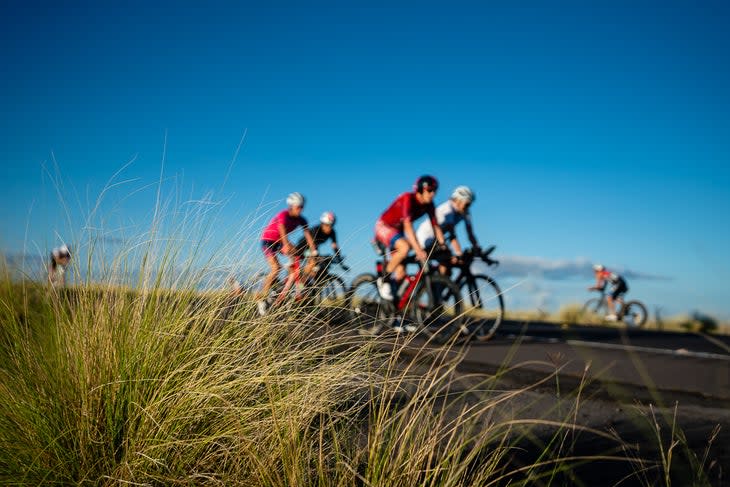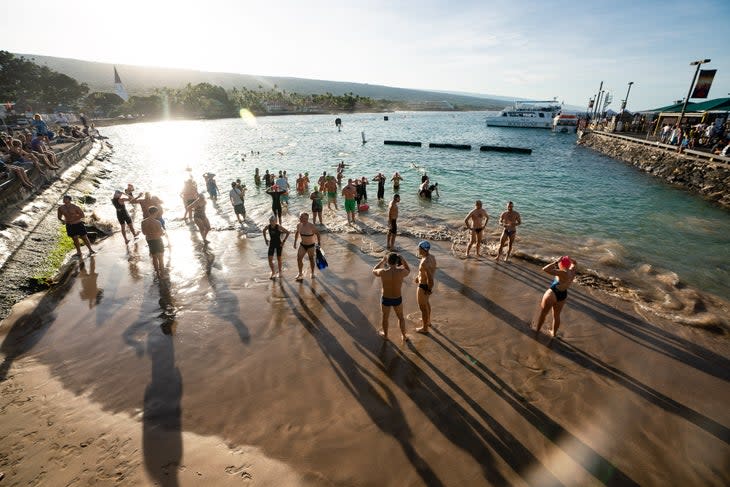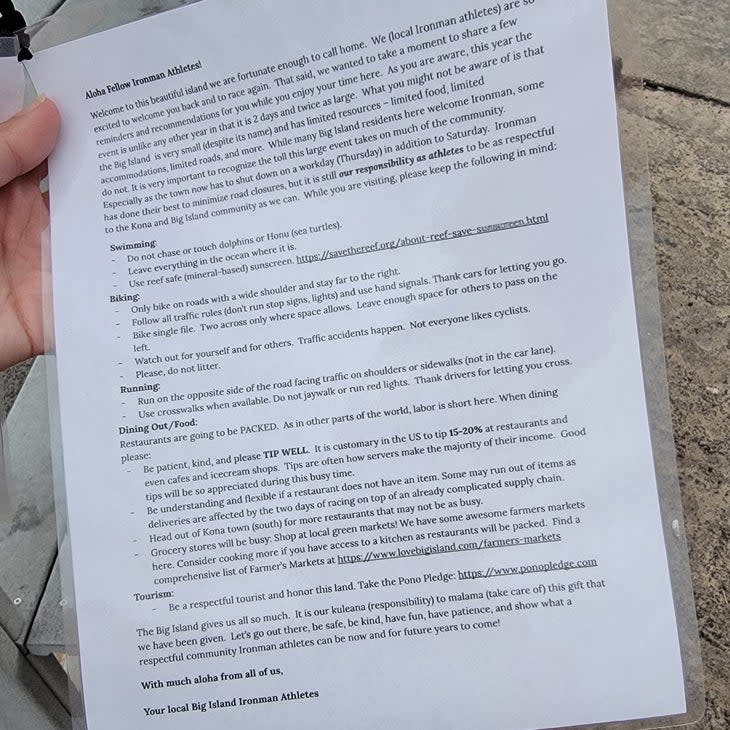Kona Locals Ask Ironman Visitors for Respect
This article originally appeared on Triathlete
In less than two weeks, the Ironman World Championship will return to the Big Island in a big way – with a two-day format to accommodate the backlog of athletes who qualified for the race in 2020, 2021, and 2022. But not everyone is happy about the return of the race and its expansion – specifically, the people who call Kona home.
“We have a lot of people who are excited because they love Ironman, but also a lot of people who do their best to avoid the race,” says Skye Ombac, a lifelong Kona resident and triathlete who will be racing in this year’s event. “This year, it just feels twice as difficult to coexist with the two-day format and twice the amount of athletes.”
The relationship between Kona and Ironman is a complicated one. Certainly, tourism is a large part of the island’s economy, and during the COVID pandemic, a decline in travel meant a loss for most residents. Many businesses closed, and hotels and restaurants operated at a fraction of their capacity. When local authorities issued shutdown orders, Hawaii unemployment levels rose to those not seen since the Great Depression, topping out at 25 percent. But even though tourism has resumed, the island still hasn’t fully recovered. Many restaurants and hotels are understaffed, as are grocery stores and gas stations.
But that doesn’t necessarily mean locals are excited about the return of tourism, either. According to a recent state-commissioned survey, 67% of Hawaii residents agreed that their island is "being run for tourists at the expense of local people,” and only 39% agreed tourism is “mostly positive.” Resident dissatisfaction with tourists is multifaceted: The overwhelming majority (92%) of locals felt visitors were not educated enough on protecting Hawaii’s natural environment and local resources; other factors include the impact of the vacation rental industry and ignorance of the residents’ quality of life. Add the extra hassles that come with hosting a two-day Ironman event, and these feelings become even stronger.
RELATED: How Is Ironman Going to Pull off Two Days of Racing in Kona?

Ironman: Not your average tourist
Though Ironman has gained support from local officials and many residents, this support is not unanimous, and it’s certainly not without condition. Ironman tourists aren’t your typical island visitors, who tend to stick to their timeshares and carefully-managed tours; they take over a host city completely, riding their bikes on the busiest roads, taking bathroom breaks on the side of sacred trails, and buying up all the bananas and bottled water at the grocery store.
On Nextdoor, a neighborhood-based social media app, the debate between local residents ping-pongs between cheering the $30 million economic impact of the race and wondering if it’s really worth the cost. Some posters shared that the road closures during two days of racing also forced their businesses to close, resulting in a loss of two days’ worth of income. Others expressed concern for the environmental impact of the race, from the large amounts of trash left on the road by athletes to the use of non-reef safe sunscreens when swimming in the ocean.
“This event has far outgrown the venue,” wrote one Nextdoor poster. “I respect the idea of Ironman and the individual athlete, but this has gotten out of hand. It is time for a new, larger venue to be found for these folks to do their thing.”
“The aloha we all had for this event has left the island,” wrote another. “Time for a change.”
“People get annoyed with cyclists taking up lanes on the road, riding on roads that are not bike friendly, not stopping at stop signs, leaving trash on the side of the road, bringing banned sunscreens to the island,” says Sierra Ponthier, a Kona resident and triathlete. “They see Ironman triathletes as selfish and just coming here to use the island for themselves while inconveniencing locals who need to get to work, to school, to family. This one hurts to hear, because as a triathlete myself, I know not all triathletes are like this, but it’s a common perception of residents here.”
“Kona is a small community, and we will have a difficult time handling twice as many athletes,” Ombac says. “There are 2,500 extra athletes coming in this year compared to a normal Ironman year. We are still recovering from COVID, businesses are understaffed and don't have the resources to handle the influx of people. Because we are racing on a Thursday, a work day, many business will be losing a ton of money and many community members are unable to get to work. This is creating a huge headache for many people.”
Ironman has worked hard to minimize the race’s logistical impact on the community, including restructuring parts of the course to allow for traffic flow and setting up shuttles further afield to transport athletes, spectators, and workers who need to be in town. Many of the people who organize the race also live on the island, so they know the unique impact the event will have on their home – for better and for worse.
Two weeks out from the race, this complicated relationship between locals and visiting triathletes is in full display. There are a lot of warm smiles and signs that say “Welcome Back Ironman.” But there are also a lot of locals honking their horns at triathletes who blow through street lights on their bikes, and just about every restaurant, people with Ironman logo tattoos can be seen complaining about long wait times. With more triathletes arriving on the island each day, patience and understanding will be key to pulling off a successful race weekend in Kona.
RELATED: Commentary: If We Want to Be Welcomed, We’ve Got to Be Better Guests

“It is our responsibility of athletes to be respectful”
At the Kona Pier, where the race transition area is located, athletes gather each morning for a practice swim. This week, new letters appeared at the pier, signed by “Your local Big Island Ironman Athletes.” The laminated pages (which are transcribed below) serve as as a how-to manual of sorts for triathletes visiting Hawaii, written by Ponthier, Ombac, and other triathletes who live and train in Kona. In addition to tips on protecting the environment and staying safe on local roads, the tutorial urges courtesy and respect for those who live on the island. There is also a digital version of this letter on Instagram, which has been shared by pros like Ben Hoffmann and Daniel Baekkegard.
“Many visiting athletes are here not obeying traffic rules on the bike and using sunscreen that is toxic to the marine life,” Ombac says. “That's why our hope is that this information can be shared so we can all do our part.”
“Nothing we are saying is revolutionary or offensive,” Ponthier says. “We’re simply stating the facts: Ironman is twice as large, there are twice as many people, this island is small, and we should all do our best to be safe and respectful to this land, this land’s people, and each other. Our hope is that visiting athletes are more aware of their actions while here and that this sparks conversations amongst athletes, Ironman Corporation, local businesses, and Mayor Mitch Roth about how we can better prepare and improve for future years. The Mayor has already approved Ironman for 2 days in 2023, so if it is to happen again, we better do everything we can to find a middle ground between the local community and Ironman.”
The Ironman organization has also asked triathletes to be respectful of the surrounding community. This week, it announced a partnership with the Hawai`i Tourism Authority's Destination Management Action Plan for responsible tourism,. The Live Aloha initiative encourages all those attending, visiting, and participating to respect and celebrate Hawaiian culture, lands, and people by taking what it calls the “Pono Pledge,” which includes such statements as “I will mindfully seek wonder, but not wander where I do not belong” and “I will not take what is not mine, leaving lava rocks and sand as originally found.”
"We know how important this race is to athletes and their supporters and that, from the minute they step on the Island, their focus is set on race day," says race director Diana Bertsch. "Live Aloha is our way of educating and encouraging athletes and visitors to be mindful of the simple yet extremely important things they can do to respect the Island and people that make this incredible event possible. Everyone can Live Aloha by obeying road rules when cycling, wearing mineral sunscreen, and avoiding stepping through gardens and nature, just to name a few. Responsible tourism starts and extends long before and after race day and if we all do our part, can make for a truly life-changing experience for all."
A message to visiting Ironman athletes from local Big Island Ironman athletes

The following copy is from letters posted on laminated paper and tied to the Kona pier. All bolding and caps belongs to the original creators:
Competing in Ironman Kona 2022? Read this! A message to visiting Ironman athletes from local Big Island Ironman athletes.
Aloha fellow Ironman athletes!
Welcome to the beautiful island we are fortunate enough to call home. We (local Ironman athletes) are so excited to welcome you back to race again. That said, we wanted to take a moment to share a few reminders and recommendations for you while you enjoy your time here. As you are aware, this year the event is unlike any other year in that it is 2 days and twice as large. What you might not be aware of is that the Big Island is very small (despite its name) and has limited resources – limited food, limited accommodations, limited roads, and more. While many Big Island residents here welcome Ironman, some do not. It is very important to recognize the toll this large event takes on much of the community. Especially as the town now has to shut down on a workday (Thursday) in addition to Saturday. Ironman has done their best to minimize road closures, but it is still our responsibility as athletes to be as respectful to the Kona and Big Island community as we can. While you are visiting, please keep the following in mind:
Swimming
Do not chase or touch dolphins or Honu (sea turtles).
Leave everything in the ocean where it is.
Use reef safe (mineral-based) sunscreen. savethereef.org
Biking
Only bike on roads with a wide shoulder and stay far to the right.
Follow all traffic rules (don’t run stop signs, lights) and use hand signals. Thank cars for letting you go.
Bike single file. Two across only where space allows. Leave enough space for others to pass on the left.
Watch out for yourself and for others. Traffic accidents happen. Not everyone likes cyclists.
Running
Run on the opposite side of the road facing traffic on shoulders or sidewalks (not in the car lane).
Use crosswalks when available. Do not jaywalk or run red lights. Thank drivers for letting you cross.
Dining Out/Food
Restaurants are going to be PACKED. As in other parts of the world, labor is short here. When dining please:
Be patient, kind, and please TIP WELL. It is customary in the US to tip 15-20% at restaurants and even cafes and ice cream shops. Tips are often how servers make the majority of their income. Good tips will be so appreciated during this busy time.
Be understanding and flexible if a restaurant does not have an item. Some may run out of items as deliveries are affected by the two days of racing on top of an already complicated supply chain.
Head out of Kona town (south) for more restaurants that may not be as busy.
Grocery stores will be busy: Shop at local green markets! We have some awesome farmers markets here. Consider cooking more if you have access to a kitchen, as restaurants will be packed. Find a comprehensive list of Farmer’s Markets here.
Tourism
Be a respectful tourist and honor the land. Take the Pono Pledge.
The Big Island gives us all so much. It is our kuleana (responsibility) to malama (take care of) this gift that we have been given. Let’s go out there, be safe, be kind, have fun, have patience, and show what a respectful community Ironman athletes can be now and for future years to come.
Which much aloha from all of us,
Your local Big Island Ironman Athletes
Can't get enough Ironman World Championship coverage? Visit our Kona Hub for news, analysis, history, photo galleries, and so much more - new stories added daily from our team on the ground at the Big Island.
For exclusive access to all of our fitness, gear, adventure, and travel stories, plus discounts on trips, events, and gear, sign up for Outside+ today.

